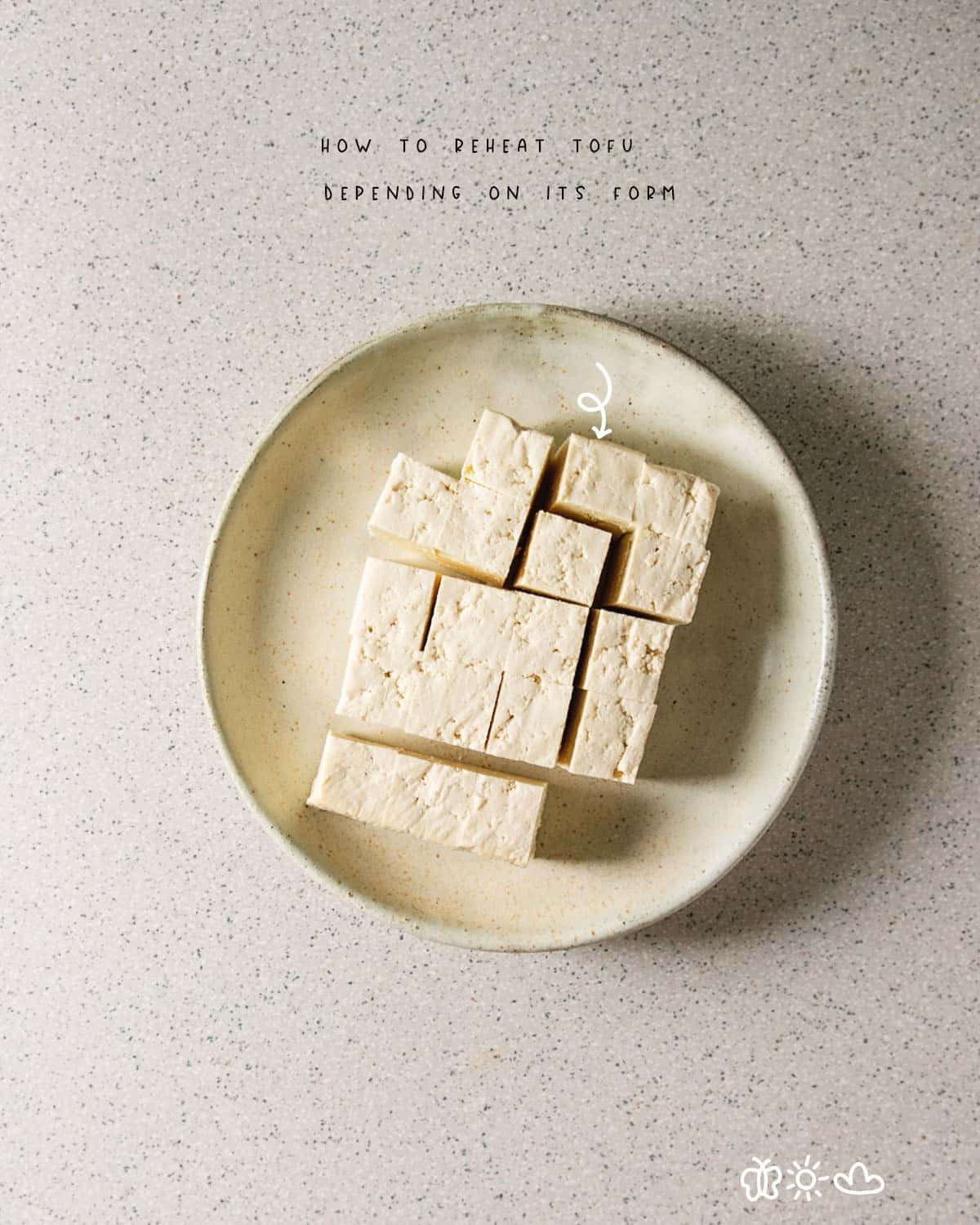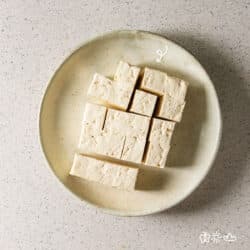Leftover tofu from last night's stir-fry? No problem! Here's a guide on how to reheat tofu, so it's just as delicious the second time.
There are many different ways to reheat tofu, but not all of them will give you the best results. In this blog post, I'll teach you the best way to reheat tofu so that it's delicious and doesn't lose its nutritional value.
The key to getting that perfect, not-soggy-or-stale texture is to follow a few simple steps. Scroll down for our top tips on how to reheat tofu so you can enjoy this delicious protein source all week!

What is tofu?
Tofu, known as bean curd, is a popular food made from soybean curds, not from fuzzy green edamame pods but from mature white soybeans that have been soaked and ground into a slurry, which is then filtered to make soy milk. The soy milk is coagulated with calcium or magnesium sulfate to make tofu. Other coagulants, such as nigari (magnesium chloride), can also be used to make tofu, but these tend to produce a more crumbly final product.
Curds and whey are separated by simmering soy milk and coagulant. The curds are then drained and pressed into blocks to remove excess water. The time it takes to press the curds determines the firmness of the tofu; it averages about 20 minutes for soft tofu, 30 minutes for regular tofu, and 45 minutes for extra-firm tofu. During pressing, more whey drains, and the product becomes drier and firmer.
Tofu can be eaten raw, but most people cook it. It can be stir-fried, stewed, grilled, baked, or deep-fried. You can use this versatile food in many dishes, from sweet to savory.
Depending on your desired result, there are a few different ways to reheat tofu. To retain as much moisture as possible, you can reheat tofu in the microwave. Simply place the tofu on a plate and microwave for 30-second intervals.
Why do people like to reheat tofu?
There are many reasons people like to reheat tofu. Some people enjoy the taste of tofu, while others appreciate its health benefits. Tofu is a good protein source and is low in calories and fat. The versatility of tofu makes it an excellent addition to many dishes.
But before we go to the reheating process, let's familiarize ourselves with different types of tofu. Knowing what kind of food we are dealing with will make reheating easier.
Read:
Steps involved in the preparation
Before diving into all the different types of tofu, discussing a few steps you should take to prepare it is necessary. Tofu has high water content, so it's a good idea to drain excess liquid to avoid diluting your flavors or causing an explosion when frying. These steps are simple but essential nonetheless.
1 When it comes to eating raw:
There is nothing complicated about it. Silken, soft tofu is ready to eat straight from the package (though, technically, you can eat any tofu raw). Remove the excess water from the dish, and enjoy!
2 Draining and Blotting:
Drain block tofu's packing water by slitting the package open and leaning it over the sink, letting it drip dry for about 5 to 10 minutes. You can also use a tofu press to speed up the process or blot away any remaining water by pressing the block of tofu between two clean, dry towels or paper towels.
For firm tofu, slice it into slabs (length-wise), about 1-inch (2.5 cm) thick. Place the tofu on a plate lined with a few paper towels, then put more paper towels on top. Use your hands to press down gently and evenly, expelling as much water as possible. Let the tofu sit for at least 10 minutes, or up to 30 minutes if you have the time; you can prepare the other ingredients while the process is taking place.
3 Pressing:
Pressing tofu helps to expel water and gives it a firmer, meatier texture that can better hold up in stir-fries or when used as an ingredient in dishes like lasagna. There are a few different ways to press tofu, but the most common is the manual method.
To press tofu manually:
- Start by draining and blotting it dry (as described in the previous step #2).
- Wrap the block of tofu in a clean, dry towel or several layers of paper towels.
- Place the tofu on a plate, then put another plate on top and weigh it down with a heavy object, such as a can of soup or a pot filled with water.
Let the tofu press for at least 15 minutes, or up to an hour if you have the time.
To speed up the process, you can also use a tofu press. Tofu presses come in various styles, but they all work essentially the same way: by using pressure to expel water from the tofu and give it a firmer texture.
4 Tofu marinating:
There is a common misconception that tofu absorbs ingredients from its surroundings. Frozen tofu with high porosity is the only type that exhibits this property. In other words, marinades won't produce many flavors unless you're willing to spend six hours sous-viding the tofu and transfusing its internal moisture.
Deborah Madison debunked this myth in her book This Can't Be tofu! She advocates infusing tofu with flavor through the glazing method. Glaze the tofu by pan-frying it until golden, with or without oil. Upon frying the exterior, add a marinade, allowing the exterior to absorb the flavors and allowing the sauce to reduce to a thick syrup.
5 Soaking and draining with salt:
For those who find pressing too time-consuming, soaking in salt water for 15 minutes can replace that step. Afterward, drain the tofu on a plate or with a paper towel. My introduction to this technique came from Andrea Nguyen's Asian Tofu. According to her, this method creates a crispier crust and texture for the tofu.
6 Freezing:
As tofu freezes, its texture changes, becoming tougher and chewier. This can be desirable in dishes like stir-fries where you want the tofu to hold its shape.
To freeze, simply remove the block of tofu from its packaging, cut it into sizes or slices as desired, and place it on a baking sheet lined with parchment paper.
Tofu will lose almost all its moisture during the freezing process, leaving behind a spongy block of tofu that you can freeze for up to 3 months. Wrap in freezer-safe paper or plastic and flash freeze for 1-2 hours, or until solid. Once frozen, you can transfer tofu to a freezer bag for more extended storage.
When ready to use the frozen tofu, thaw it in the refrigerator overnight. Once melted, press and drain the tofu as you would for fresh.
Reheating instructions:
Tofu can be reheated in many ways, depending on the dish you're making and your personal preferences.
In the Microwave:
The quickest way to reheat tofu is in the microwave. Cut the tofu into small pieces, place it on a microwave-safe plate, and heat in 20-second increments until warm.
On the Stove:
You can also reheat tofu on the stove. To do so, cook the tofu in a small amount of oil over medium heat until browned and warmed.
In the Oven:
The oven is your best bet if you're reheating a large amount of tofu or want a crispy texture. Preheat the oven to 375° Fahrenheit and spread the tofu in a single layer on a baking sheet. After about 7 to 10 minutes, remove from the oven and let cool.
How to reheat tofu (depending on its type)
Tofu is available in different forms, textures, and styles. Here are some of the most common types of tofu and how to reheat them:
For block Tofu
A grocery store or restaurant is usually the best place to find block tofu. You can buy a block of tofu that has been pressed and compacted for a firmer texture or one that has been extra-firmly pressed for a meatier chew. The curds-and-whey method produces a fluffy texture called "cotton tofu." Water-filled plastic trays or vacuum-packed packages are available.
Is regular tofu the same as block tofu?
Regular tofu and block tofu are the same things. "Regular" simply refers to the fact that it is the most common type of tofu sold in stores.
1 Soft block tofu
Soft tofu is pressed for the shortest time, resulting in a seamless, custardy texture. Despite its smoothness, the block still has texture and body. It's perfect for crumbling into a dish or pureeing into a sauce. It has a mild, milky flavor and a delicate body, similar to Jell-O. This tofu is a neutral base for sweet elements and works well with savory dishes.
Shallow frying soft block tofu gives it a crispy exterior while maintaining its custardy interior. You can also steam, braise, or add it to the soup. In contrast, battering and deep frying yield a firmer block and crunchy exterior. When working with soft tofu, handle it with care as it is delicate and can break easily.
How to reheat soft block tofu:
This tofu requires special care when reheating. The best way to reheat soft block tofu is in a water bath.
- Step 1: Fill a pot with water and bring it to a simmer on the stove.
- Step 2: Place the soft tofu block in a heat-safe bowl or container.
- Step 3: Carefully lower the bowl into the pot of simmering water.
- Step 4: Let the tofu heat up for 3-5 minutes or until warmed through.
- Step 5: Remove the bowl from the pot and enjoy your reheated tofu!
2 Medium block tofu
The texture of medium-firm tofu is rougher than soft tofu - you can see the curds, but it still cracks when you handle it. Despite its moderate moisture content, it can look droopy, which is why it's good for dishes requiring minimal manipulation, such as braising or boiling.
Due to the higher amount of whey, the flavor is more pronounced than soft tofu. It's also less delicate, so it can be stir-fried or deep-fried without falling apart. But with vigorous stir-frying, the tofu may become deflated tofu planks.
How to reheat medium block tofu:
Since this tofu can withstand extended heat, it is easy to reheat without losing shape. The best way to reheat medium block tofu is in a pan on the stove.
- Step 1: Heat a pan on the stove over medium heat.
- Step 2: Add oil to the pan and let it heat up.
- Step 3: Add the tofu to the pan and let it cook for 2 to 3 minutes, flip it over and cook for an additional 1 to 2 minutes or until heated through.
- Step 4: Remove the tofu from the pan and enjoy!
3 Firm block tofu
Of all the tofu varieties, this is the workhorse. When you doubt which tofu to buy, pick a firm block that works with most savory recipes. In firm block tofu, you should see the curds clearly; the texture should be solid. Its firm body gets slightly rubbery in cooking, allowing you to handle each block easily. Firm tofu holds up quite well to frying and stuffing.
How to reheat firm block tofu:
This tofu is easy to reheat due to its ability to maintain its shape when heated for a long time. The best way to reheat firm block tofu is in a pan on the stove.
- Step 1: Heat a pan on the stove over medium heat.
- Step 2: Add oil to the pan and let it heat up.
- Step 3: Add the tofu to the pan and let it cook for 2 to 3 minutes, flip it over and cook for an additional 1 to 2 minutes or until heated through.
- Step 4: Remove the tofu from the pan and enjoy!

For silken tofu
Another popular style of tofu is silken tofu. As the name suggests, this tofu has a softer, silkier texture than regular tofu. Silken tofu is also more delicate and can easily fall apart. Making it requires the same process as making the "block tofu," except the soy milk does not curdle during coagulation.
In the absence of curds, the tofu—soft, firm, or extra firm—takes on a smoother, gelatinous texture. It is more delicate than block tofu, and handling it too roughly can cause it to fall apart. It is also left unpressed, retaining all its moisture while cooling.
This type of tofu is soft and smooth in texture. It has high water content and is often used in tofu desserts or as an ingredient in creamy sauces. This undrained, unpressed Japanese-style tofu has a custard-like consistency depending on how much soy protein it contains. It is often labeled soft, firm, or extra firm.
Silken tofu works well as a dairy-free base for smoothies, sauces, and dips. In baking recipes, you can also use it to make vegan cheese, mayonnaise, or egg substitute.
1 Soft silken tofu
This soft tofu is delicate and heavy with a soft custard-like texture that falls through under its own weight. It's usually used in soups or blended into dips, as it doesn't hold its shape well. Soft tofu has a higher water content than firm tofu and is often used in soups or as a meat alternative in dishes such as Mapo tofu. Tofu like this is used in vegan desserts, saucy recipes, and egg substitutes.
How to reheat soft silken tofu:
- Step 1: Pour boiling water over the tofu and let it sit for 1-2 minutes.
- Step 2: Remove the tofu from the water and add it to your dish.
2 Firm silken tofu
Firm silken tofu is good for dishes where you want a creamy texture but some shape, such as in vegan quiches or lasagna. Firm silken tofu has a little more structure than soft silken tofu but is still quite delicate. Don't confuse it with firm block tofu, as it won't hold its shape and will fall apart if you manipulate it further.
How to reheat firm silken tofu:
- Step 1: Boil some water in a pot.
- Step 2: Put the tofu in a heat-proof bowl and pour the boiling water over it.
- Step 3: Leave it for a few minutes to heat through.
3 Extra-Firm Silken Tofu
This type of tofu is even denser than firm and has a chewy texture. This tofu holds its shape like Jell-O. The product can be handled easily with your hands, without breaking. Extra-firm silken tofu is ideal for stews and braises, particularly when you need to turn it frequently. I would avoid using extra-firm silken and regular brick tofu, though you can bake and stir fry it.
What to do with the leftovers?
Tofu divided people into two groups: those who love it and those who don't know how to cook it. Some think of tofu as bland, but this versatile ingredient takes on the flavors of whatever it's cooked with.
Since you're here looking for ways to use leftover tofu, we assume you already know how to cook it and are left with extras. What do you do with it?
The best way to reheat tofu is by gently pan-frying it, and we'll show you how.
Option 1
If you cooked your tofu in a sauce
Whenever you want to reheat tofu cooked in a sauce, the best way to reheat it is by gently pan-frying it. Why? By pan-frying it, you'll be able to crisp up the outside of the tofu while keeping the inside moist.
Simply reheat it in the same sauce. Add a little water or vegetable broth to thin it out if necessary. Also, this will help the sauce adhere to the tofu and prevent the tofu from drying out.
Here's how to do it:
- Step 1: Heat the oil over medium heat in a medium-sized pan.
- Step 2: Cut the tofu into cubes or slices according to its original cooking method.
- Step 3: Add the tofu to the pan and heat it over medium heat until it becomes crispy.
- Step 4: Put the leftover sauce on top and serve. (Note: You can microwave the leftover sauce for 20-second intervals.)
Option 2
If you cooked your tofu without a sauce
If you cooked your tofu without a sauce, you could still reheat it by pan-frying it. But this time, we recommend marinating the tofu before cooking it. As a result, you won't have to worry about the tofu drying out.
Here's how to do it:
- Step 1: Cut the tofu into cubes or slices, depending on how you cooked it.
- Step 2: Mix the marinade ingredients of your choice in a bowl. We like to use a combination of soy sauce, rice vinegar, and sesame oil.
- Step 3: Add the tofu to the bowl and let it sit for at least 15 minutes, or up to a few hours if you have the time.
- Step 4: Heat a pan over medium heat and add oil.
- Step 5: Add the tofu to the pan and cook for a few minutes until crisp and heated.
- Step 6: Add the leftover marinade on top and wait until heated before serving.
Another option:
If you cooked your tofu plain with just a bit of seasoning, you should marinate it before reheating. Why? Well, because tofu is porous, it absorbs flavors well. So, when you reheat it, those same flavors will come through and make your dish even tastier.
Here's how to do it:
Step 1
Marinate your tofu in your favorite sauce or marinade. (Mix some soy sauce and rice vinegar and add sugar or honey according to your reference). Optional: sprinkle some minced garlic or ginger because they go well with everything.
Step 2
Let it sit for at least 30 minutes, but the longer, the better.
Step 3
Preheat your oven to 350°F and bake the tofu for about 5 to 7 minutes or until heated. Baking tofu gives it a crispy exterior while keeping the inside moist.
Step 4
Serve immediately with your favorite dipping sauce or over a bed of rice, noodles, or vegetables. You can also add it to your stir-fry.
Step 5
Another option is to reheat your tofu in the microwave. Just make sure to add a bit of water or oil to prevent it from drying out.
Step 6
A soup or stew is a good way to reheat your tofu. You can use this option for those looking to add a little extra protein to their meals. If you are reheating soup or stew, just add the tofu.
Option 3
If you have tofu that's already cold
If you have tofu that's already cold, you can reheat it in the microwave. Just be careful not to overcook it, or it will become rubbery.
Here's how to do it:
1. Cut the tofu into cubes or slices, depending on how it originally was cooked.
2. Place the tofu on a microwave-safe plate.
3. Microwave for 15-second intervals or until heated through.
4. Serve with the leftover sauce on top.
Option 4
If you want to eat the tofu cold
If you want to eat the tofu cold, there's no need to reheat it. Just add it to your favorite salad or sandwich.
Or, if you're feeling adventurous, try one of these tofu recipes:
- Spicy Thai Tofu Salad
- BBQ Tofu Sandwich
- Crispy Tofu with Sweet and Sour Sauce
- Tofu "Noodle" Soup
- Spicy Tofu and Vegetable Stir-Fry
- General Tso's Tofu
How long does tofu last in the fridge?
As with most food products, the shelf life of tofu depends on several factors, including how it is stored. Unopened, store-bought tofu generally has a best-by date; however, if properly stored, it can be eaten beyond that date. Once opened, the race is on to consume it before it goes bad.
An open package of tofu sitting in water will last up to a week in the fridge; if stored covered adequately in water inside a resealable container, it will last up to 10 days. If unsure when you opened the package, give it the sniff test. If it smells sour or off, it's time to toss it.
In the fridge, cooked tofu can last for four days. If you're reheating it, bring it to an internal temperature of 165 degrees Fahrenheit to kill harmful bacteria.
Tips for extending the shelf life of tofu:
- Store unopened packages of tofu in the fridge.
- Once opened, store tofu in a resealable container filled with water.
- Change the water daily to keep the tofu fresh.
- You can store cooked tofu in the fridge for up to four days.
- Reheat cooked tofu to an internal temperature of 165 degrees Fahrenheit.
- Freeze tofu to extend its shelf life up to six months. Frozen tofu can be thawed and used in any recipe for cooked tofu.
Homegrown or homemade tofu (recipe here) will last two to three days. Freezing is your best bet if you want your tofu to last longer. Frozen tofu will keep for up to 6 months.
What is the best way to store tofu?
The best way to store tofu is to keep it in the refrigerator. When ready to eat the tofu, simply remove it from the fridge and reheat it in a pan or the microwave. Tofu can be stored in the refrigerator for up to a week if stored properly.
How to do it:
Step 1
First, remove from the packaging and drain any excess water. Wrap it in a clean towel. It prevents the tofu from drying out.
Step 2
Place the wrapped tofu in a container with an airtight lid and cover it with water.
Step 3
Storing the tofu in water helps keep it moist and prevents it from drying. Change the water every day to keep the tofu fresh. Changing the water every day ensures that the tofu stays fresh.
Step 4
When ready to use the tofu, drain it and press it to remove any excess water. If you don't remove the excess water, the tofu will be waterlogged and won't cook properly. Pressing the tofu also helps to firm it up, making it easier to work with.
Step 5
Cut the tofu into cubes or slices, depending on how you use it.
Step 6
To reheat, cook the tofu in a pan over medium heat until heated. You can also reheat it in the microwave. Simply place the tofu on a plate and microwave for 15-second intervals or until heated through.
Reheating tofu is quick and easy, and there are many different ways to do it. Simply choose the method that works best for you.
How to tell if tofu has gone bad
Identifying the signs of tofu that have gone bad is crucial because it can help you save money by eating the tofu before it spoils. Because tofu is a perishable food, it will eventually spoil. However, if you know the signs of tofu that have gone bad, keeping it from spoiling can save you money.
1 The color and appearance
Bad tofu exhibits a yellow color as its first sign. Tofu is typically white or off-white, but if it has darkened or developed brown or gray patches, it is no longer edible, and you should throw it out.
Why is that? The answer is simple: oxidization. When tofu oxidizes, the oxygen in the air starts to break down the structure of the tofu. This process is not only responsible for the color change but also for the change in texture.
Bad tofu will have a spongy texture, while good tofu should be firm to the touch.
2 Slimy surface
When you notice a slimy surface on the tofu, it's time to throw it away. Why is that? Because the proteins in the tofu have started to break down and form a slimy surface. Bacteria is usually the culprit when it comes to tofu turning bad.
3 Bad smell
If tofu has a sour or ammonia-like smell, discard it. The bacteria that cause tofu to go bad creates those smells as it starts to break down the proteins in tofu, making tofu taste bad.
The rule of thumb for tofu is that bad smells mean bad food. Tofu should have no smell whatsoever. If your tofu has a sour or off scent, throw it out.
4 Mold
Mold is a fungus that can grow on many different types of food, including tofu. Mold is dangerous to consume because it can produce toxins that make you sick. If you see mold on your tofu, it's a sure sign that it's gone bad, and you should get rid of it as soon as possible.
If you see mold on your tofu, it is best to err on the side of caution and throw it away.
5 Texture
One of the most obvious ways to tell if tofu has gone bad is by its texture. Fresh tofu is smooth, silken, and creamy, while bad tofu will be chalky, dry, and crumbly. Why? Because it has lost all of its moisture. Tofu is composed of about 80% water, so when it dries out, it becomes crumbly. And when tofu dries out, it also loses its flavor. Besides being chalky and crumbly, bad tofu may also be yellow or green.
However, there's still hope!
a.) Soak it in water
If your tofu is dry but not moldy, you can try to rehydrate it by soaking it in water for 30 minutes. After it has soaked, drain the water and press the tofu to remove any excess moisture. Then, cook it as you normally would.
b.) Marinate for 30 minutes
If your tofu is starting to get chalky, you can try to salvage it by marinating it for 3 minutes or cooking it in a sauce. It will make the tofu more palatable and rehydrate it.
c.) Add it to soup or stew
Another way to use dry, crumbly tofu is to add it to soup or stew. The soup or stew will help to rehydrate the tofu and make it more flavorful.
6 Taste
Of course, the taste is the best way to tell if tofu has gone bad. You should toss it if it tastes sour, bitter, or otherwise off.
You should always throw something away when in doubt! If you're unsure whether or not your tofu has gone bad, don't risk it. The perishable nature of tofu means that, like all other items, it is susceptible to bacteria that can make people ill.
7 Use by date
Tofu also has a use-by date, so check it before you buy it. Once the tofu has reached its use-by date, it is no longer safe to eat. And, even if the tofu doesn't smell or taste bad, it may still harbor harmful bacteria.
Tofu is a perishable food item, and, like all other items, it can harbor harmful bacteria that can make you sick. Better to be safe than sorry! If you're unsure how to tell if tofu has gone bad, the best thing to do is to throw it out.
How to Reheat tofu (step by step guide)
Pin RecipeIngredients:
- leftover tofu
Instructions:
How to reheat soft block tofu:
- Fill a pot with water and bring it to a simmer on the stove.
- Place the soft tofu block in a heat-safe bowl or container.
- Carefully lower the bowl into the pot of simmering water.
- Let the tofu heat up for 3-5 minutes or until warmed through.
- Remove the bowl from the pot and enjoy your reheated tofu!
How to reheat medium block tofu:
- Heat a pan on the stove over medium heat.
- Add oil to the pan and let it heat up.
- Add the tofu to the pan and let it cook for 2 to 3 minutes, flip it over and cook for an additional 1 to 2 minutes or until heated through.
- Remove the tofu from the pan and enjoy!
How to reheat firm block tofu:
- Heat a pan on the stove over medium heat.
- Add oil to the pan and let it heat up.
- Add the tofu to the pan and let it cook for 2 to 3 minutes, flip it over and cook for an additional 1 to 2 minutes or until heated through.
- Remove the tofu from the pan and enjoy!
How to reheat soft silken tofu:
- Pour boiling water over the tofu and let it sit for 1-2 minutes.
- Remove the tofu from the water and add it to your dish.
How to reheat firm silken tofu:
- Boil some water in a pot.
- Put the tofu in a heat-proof bowl and pour the boiling water over it.
- Leave it for a few minutes to heat through.
If you cooked your tofu in a sauce:
- Heat some oil over medium heat in a medium-sized pan.
- Cut the tofu into cubes or slices according to its original cooking method. (this is optional)
- Add the tofu to the pan and heat it over medium-low heat until it becomes crispy.
- Put the leftover sauce on top and serve. (Note: You can microwave the leftover sauce for 20-second intervals.)
If you cooked your tofu without a sauce:
- Cut the tofu into cubes or slices, depending on how you cooked it.
- Mix the marinade ingredients of your choice in a bowl. We like to use a combination of soy sauce, rice vinegar, and sesame oil.
- Add the tofu to the bowl and let it sit for at least 15 minutes, or up to a few hours if you have the time.
- Heat a pan over medium heat and add oil.
- Add the tofu to the pan and cook for a few minutes until crisp and heated.
- Add the leftover marinade on top and cook for a minute or until heated up.
Notes:
Tips for extending the shelf life of tofu:
- Store unopened packages of tofu in the fridge.
- Once opened, store tofu in a resealable container filled with water.
- Change the water daily to keep the tofu fresh.
- You can store cooked tofu in the fridge for up to four days.
- Reheat cooked tofu to an internal temperature of 165 degrees Fahrenheit.
- Freeze tofu to extend its shelf life up to six months. Frozen tofu can be thawed and used in any recipe for cooked tofu.
Please note that all nutrition information are just estimates. Values will vary among brands, so we encourage you to calculate these on your own for most accurate results.





